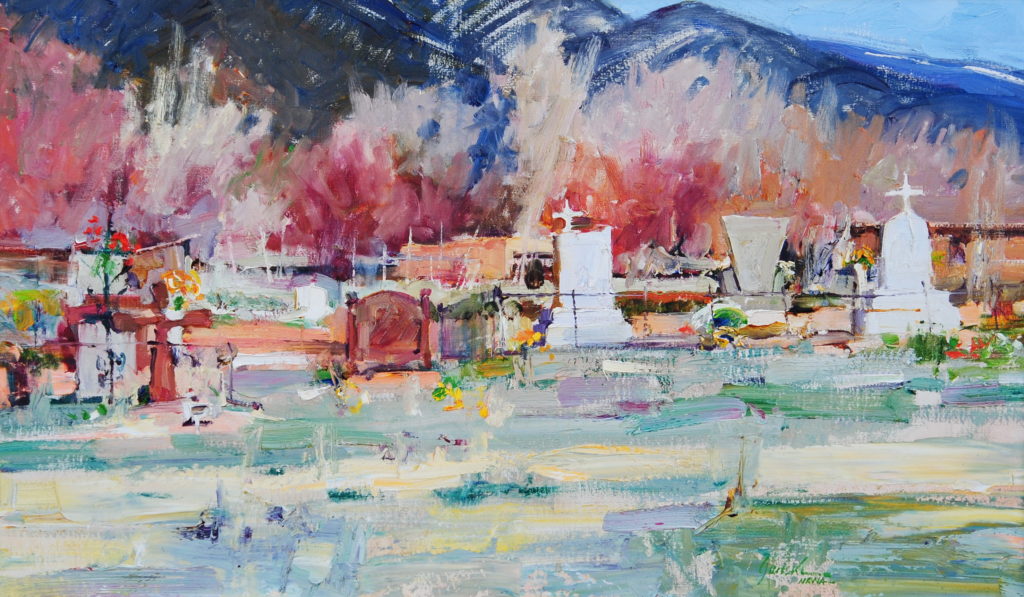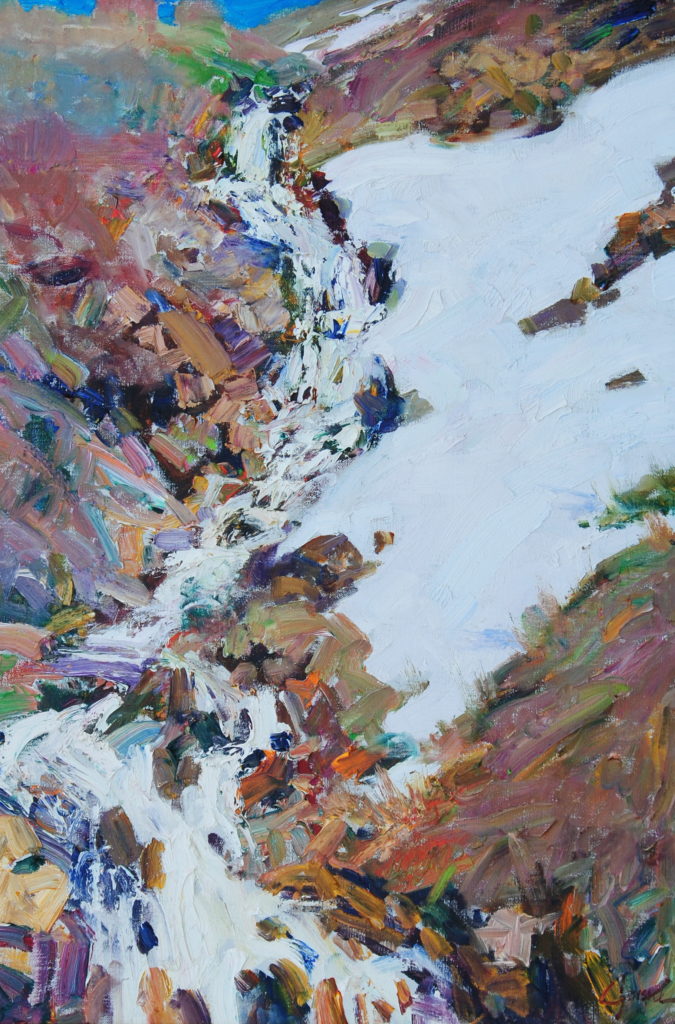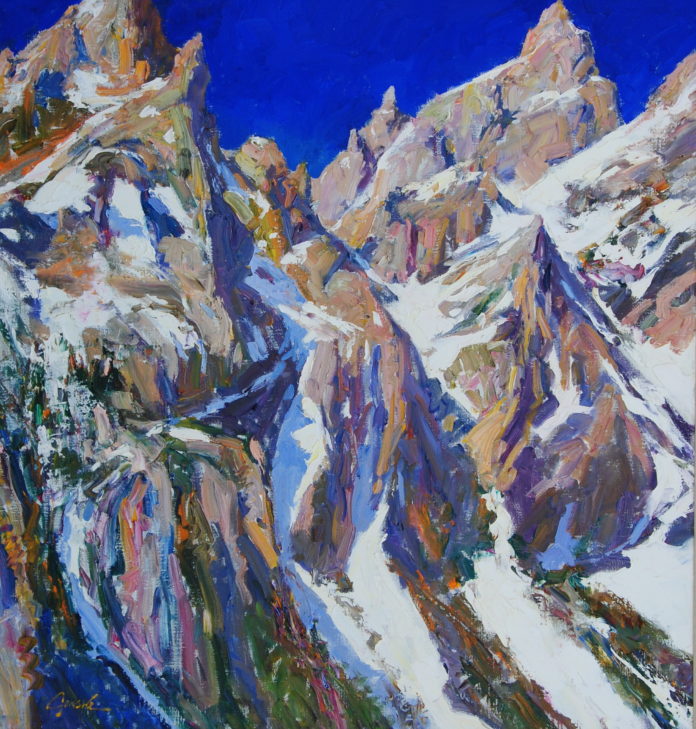Oil Paintings by Walt Gonske: “My best work comes when I’m able to give up control … Then the painting takes on a life of its own.”
Walt Gonske Looks Back
BY KELLY COMPTON
Born in Newark, New Jersey, Walt Gonske grew up in Irvington nearby. After three years of art school in Newark, he worked for advertising agencies in New Jersey before another three years of study, this time in Manhattan with the legendary painter-illustrator-muralist Frank J. Reilly (1906–1967). Reilly advised his pupils not to expect to make a living as fine artists until, in his words, “you have a few gray hairs.”
Rather, he suggested they become illustrators to keep their skills sharp, so Gonske duly began freelancing in men’s fashion advertising in 1967. He recalls picking up garments at the agency or store one day and delivering his illustrations of them the next morning. This may not have been “high” art, but it was, in Gonske’s view, “a good experience of working under pressure.”
In 1971, Gonske visited his sister in Taos and promptly fell in love with New Mexico: “Having grown up in New Jersey,” he recalls, “I was fascinated by the quality of light at 7,000 feet.” He was also surprised that galleries in Santa Fe and Taos were selling so much representational art — something nearly impossible to find back in Manhattan. (Traditional modes never fully disappeared in the American West, fortunately.)
“I thought about how wonderful it might be to live in Taos and paint landscapes, maybe even sell some,” Gonske recalls. In Taos he took photos of the spectacular scenery all around, brought them back to New York, and painted watercolors from them. His sister found an Albuquerque gallery willing to accept them on consignment, and soon “I received a check for $66.67, my two-thirds share from the sale of a full sheet watercolor. Hot damn! A fine art check: that was all it took. I said, ‘I’m out of here!’” The timing was fortuitous, as fashion illustration was rapidly being replaced by photography.
So, early in 1972, when he was 29, Gonske moved to New Mexico, and began the new life he still leads today. At first, he was not prepared for the slower pace: When an Albuquerque gallery wanted him to mount a solo show, “I assumed the owner would want 30 works by the end of the week.” Happily, he had much longer to create them. Gonske continued to paint watercolors from photos, which sold very well, but in 1974 he shifted to oils, refusing to supply his (suddenly unhappy) galleries with more watercolors. This was a difficult phase, but he survived it.
The Switch to Oil Paintings
Gonske’s first oil paintings were made in the studio, but at some point he got a French easel and began working outdoors. “In 1985,” he says, “I bought a van with an extended fiberglass top that allowed me to stand inside and paint out one of the three opened windows. After making that first painting, I remember thinking, ‘This is terrific. I’m out of the wind, rain, and snow, my eyes are protected from the sun’s glare, and nobody bothers me.’” Gonske is now on his fourth “paintmobile,” in which he creates both studies and larger, finished canvases.

FEELING INTO PAINT
When admiring Gonske’s oil paintings, many viewers struggle to describe what they see, or who his work reminds them of. It is brilliantly colored, highly expressive plein air imagery, of course, yet there’s something faintly recognizable about the handling — not derivative at all, just somehow connected to the past.
The answer eventually becomes clear — Nicolai Fechin (1881–1955), the great Russian-born painter who lived in Taos during the late 1920s and early 1930s. In 1966 Reilly had sent Gonske and other students to see a Fechin show in New York, an experience that made a powerful impression on the young man.
That visit occurred six years before Gonske settled in Taos, where the Russian’s home and studio are now the Taos Art Museum.

About his technique, Gonske muses, “I went to art school to learn the rules of drawing and painting. After many years of developing skills and acquiring knowledge, I know what I will get as a finished product if I control the process. What I don’t know is where it will lead if I give up control. Now the idea is just the first impulse. From then onward, improvisation takes over.
“The end result is not about that first idea, but instead a record of all those impulses along the way. Each stroke of paint carries emotion and power. I work in a loose, painterly style in part because I want the viewer to see the process and not hide it behind ‘finish’ —for the viewer to maybe even feel how a particular piece of paint was put down. My goal is not to show what I know, but what I feel.
“The more intensely I can express emotion through paint about the subject, the more likely the viewer will respond. My best work comes when I’m able to give up control, to trust my impulses. Then the painting takes on a life of its own.”

> Visit EricRhoads.com to learn about more opportunities for artists and art collectors, including retreats, international art trips, art conventions, and more.
> Sign up to receive Fine Art Today, our free weekly e-newsletter featuring contemporary oil paintings, pastels, acrylics, and sculptures for art collectors
> Subscribe to Fine Art Connoisseur magazine, so you never miss an issue








